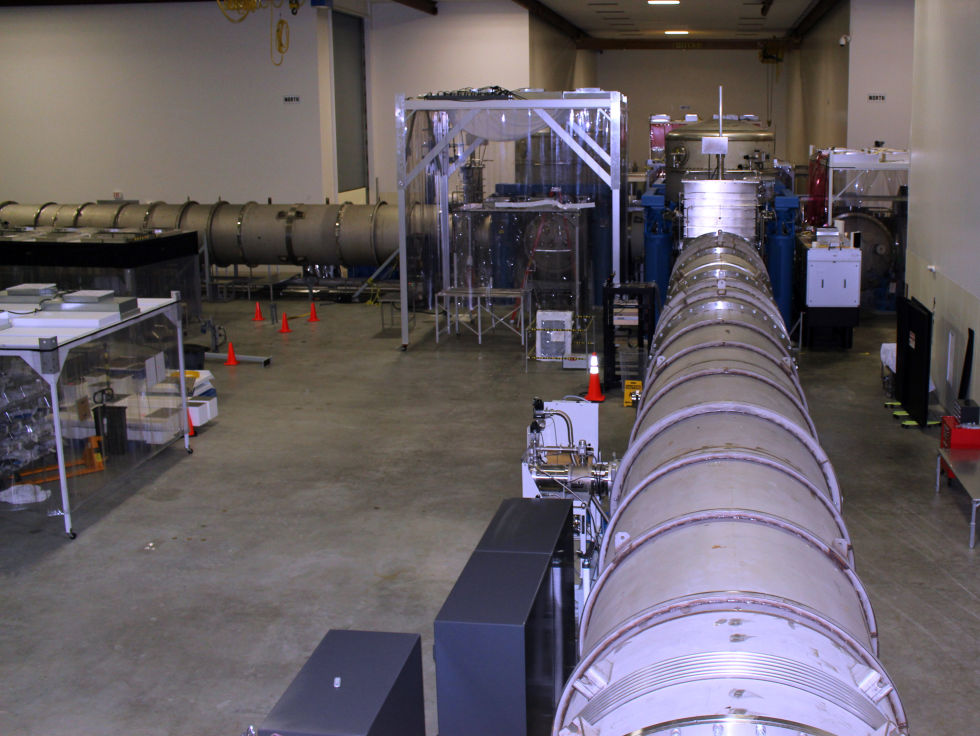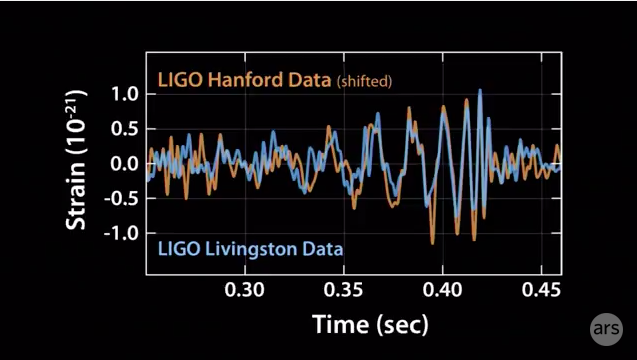
LIVINGSTON, Louisiana—In a large press event today, the scientists behind the LIGO experiment announced the first direct detection of gravitational waves, ripples in the fabric of space-time generated by strong gravitational interactions. The news, following weeks of rumors, confirms a major prediction of general relativity, and comes a century after Einstein first formulated the theory.
The waves, produced in the final moments of a black hole merger, arrived precisely at 5:51 in the morning (US Eastern) on September 14th last year, and were picked up by both LIGO detectors—one in Louisiana, one in Washington. Since the Louisiana detector picked up the signal a few milliseconds sooner, the event that produced the gravitational waves occurred in the Southern Hemisphere.
"The description of this observation is beautifully described in the Einstein theory of general relativity formulated 100 years ago," said MIT professor Rainer Weiss, part of the team that first proposed LIGO. He said it "comprises the first test of the theory in strong gravitation."
-
A celebration was held in Livingston, La., today at the LIGO detector to mark the discovery of gravitational waves.Eric Berger
-
Joe Giaime, the physicist who manages the lab, takes an audience question.Eric Berger
-
Two graduates of Louisiana universities were at the lab's controls at 4:51 a.m. CT when the discovery was made.Eric Berger
-
E-mails started flying shortly thereafter among the physicists in the collaboration.Eric Berger
-
After the presentation physicists and local dignitaries gathered to celebrate.Eric Berger
-
The did so in the lab's science center, which is normally populated with area school children.Eric Berger
Gravitational waves are a consequence of general relativity. They're generated when two massive bodies are in close orbit around each other. Rather than entering a stable orbit, their interactions produce gravitational waves, ripples in the fabric of space. These waves carry energy away from the system, allowing the orbits to decay, eventually leading to a merger of the system.
General relativity makes some rather precise predictions about how quickly gravitational energy should radiate away from systems like this. We've discovered a number of binary systems over the years composed of massive, compact objects like neutron stars (the first such discovery was awarded a Nobel Prize). And, in each case, the behavior of these systems was consistent with the predictions of general relativity.
But the gravitational waves were still missing in action. Attempts to find them, including an earlier iteration of LIGO, came up empty. And a general search for their influence on astronomical objects also turned up nothing.
But the agreement between Einstein's predictions and observations provided a strong motivation to keep looking. It was enough to get the National Science Foundation to foot the bill for LIGO's upgrade. And the NSF's bet has clearly paid off.
Based on the details of the signal detected, the LIGO team estimates that the event that generated the gravitational waves occurred 1.3 billion years ago. That's when two black holes, one 29 times the mass of the Sun, the second 36 times, spiraled into each other. When the collision took place, the equivalent of three times the mass of the Sun was converted directly to energy and released in the form of gravitational waves. For a brief fraction of a second, this single event produced more power than the entire rest of the visible Universe combined.
The detection occurred during a period where the upgraded detectors were being commissioned, but researchers indicate that they ran this engineering phase just as they would in scientific mode, so they feel confident in the find. The waves received at the two detectors also matched up well with each other, as shown above, and also matched the predictions made by modeling black hole mergers on supercomputers.

Despite their short duration, the waves are very information rich, with details regarding their shape, frequency, and the number of peaks all telling us about the event that produced them, and possibly the nature of gravity itself.
These events are exceedingly rare. But the successful detection of one means that we now have the hardware in place to pick them up whenever they occur. Its success doesn't mean that LIGO will be shut down; instead, with this discovery, gravitational waves move from a theoretical construct to another avenue for studying the cosmos. Gravity wave astronomy could tell us key things about the dynamics of our galaxy, and spot extremely energetic events elsewhere. It would be a bit like gaining the ability to do observations at a new set of wavelengths.
In this sense, LIGO is now a bit like the IceCube neutrino detector. After confirming that astronomical events sent extremely high-energy neutrinos screaming towards Earth, IceCube has now started to search for the source of these neutrinos, ushering in the era of neutrino cosmology.
"This detection is the beginning of a new era: the field of gravitational wave astronomy is now a reality," said Gabriela González of Louisiana State University. Black hole expert Kip Thorne stated, "With this new discovery, we humans are embarking on a marvelous new quest: the quest to explore the warped side of the Universe—objects and phenomena that are made from warped spacetime."
To provide more precision to that astronomy, the LIGO collaboration will be integrating with the European Virgo detector, which is based on a similar approach. Another detector is planned for Japan, and negotiations are under way to build a LIGO-like detector in India. With four in operation, we'll someday be able to say something more than "somewhere in the Southern Hemisphere."
reader comments
353